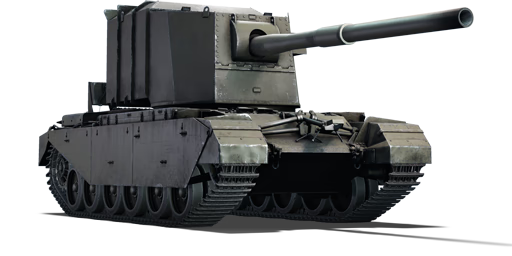



Following the debut of the IS-3 in 1945 and amidst fears that the Soviet Union would continue developing increasingly heavy tanks, a requirement was drawn up in 1950 for a tank with a gun capable of defeating a 152 mm armour plate sloped at 60° from up to 2 km. However, it was quickly realised that even the most powerful Allied guns of the time, namely the 120 mm cannon of the Conqueror and the American 155 mm mounted to tanks such as the T30, were not able to perform such a feat. Instead, a new 183 mm cannon was developed, firing HESH shells to allow both anti-armour and anti-fortification use. It was originally planned to mount the new gun on the same "Universal tank" hull as the Conqueror. However, this would take significant development, so it was decided to initially provide a stop-gap measure by utilising the hull of the Centurion, becoming the FV4005. The first prototype ("Stage I") mounted the gun in an open turret, featuring a concentric gun recoil system, mechanised loading assistance, and a recoil spade mounted on the rear of the chassis to allow the vehicle to dig in when firing. Following from this, "Stage II" featured a light but fully enclosed turret, doing away with the loading assist by providing space for an extra loader, as well as replacing the concentric recoil system with a new hydropneumatic version. However, the IS-3 and its developments did not materialise in as great numbers as was feared, and the project was officially cancelled in 1957.
Introduced in Update 1.67 "Assault", the FV4005 Stage II is truly the epitome of a "glass cannon". With the largest-calibre conventional tank gun in the game at 183 mm, even glancing hits from its powerful HESH shells tend to result in significant damage to a target. Despite their size, the shells have decent muzzle velocity, making them relatively easy to range and aim. However, the size of the shell can also pose a challenge, being likely to glance off extraneous components such as the barrel, leading to minimal internal damage; coupled with the particularly long reload, extreme care is required when taking a shot. Traverse is also limited to ±45°, due to the strong recoil. While the gun is extremely effective, the same cannot be said for its mount. The Centurion chassis struggles under the weight of the gun, resulting in rather mediocre mobility, while the turret, only lightly armoured to compensate, can be defeated by even .50 cal rounds. The survivability is both helped and hindered by the tank's spacious nature: while it is a large, highly visible target, a single shot often is not enough to take out the dispersed crew (unless it detonates the large ammunition lining the turret's sides), allowing the vehicle to retreat and reposition.
| Ammunition | Type | Armor penetration (mm) at a distance: | |||||
|---|---|---|---|---|---|---|---|
| 10 m | 100 m | 500 m | 1000 m | 1500 m | 2000 m | ||
| HESH | 228 | 228 | 228 | 228 | 228 | 228 | |
| Belt | Belt filling | Armor penetration (mm) at a distance: | |||||
|---|---|---|---|---|---|---|---|
| 10 m | 100 m | 500 m | 1000 m | 1500 m | 2000 m | ||
| AP/T | 13 | 12 | 7 | 3 | 2 | 0 | |












Mobility | |
|---|---|
Protection |
|---|
Firepower |
|---|